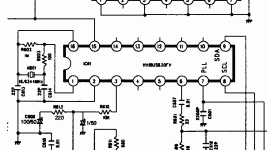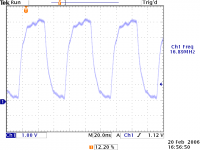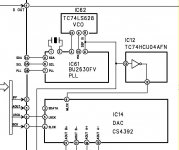Does anyone know what the crystal frequency of the the CD5400?
The service manual says something about a 8Mhz and a 8.467 Mhz crystal, but looking at the datasheet of the DAC, that can't be correct...
The service manual says something about a 8Mhz and a 8.467 Mhz crystal, but looking at the datasheet of the DAC, that can't be correct...
16.9344MHz. But a new clock doesn't want to go in in place of the existing crystal, it needs to go in after the rather nasty PLL and digital synthesiser that allows pitch control. I'll be fitting one of Guido Tent's clocks to mine and I'll post details once done.
Ah, thanks 🙂 but why doesn't it say anything about that in the service manual.. Strange stuff.
I was also wondering about the BU thing. It would make sence that it is used for the pich control. I don't care about it. If would lose it, I won't miss it. it would be great to get the details!
I was also wondering about the BU thing. It would make sence that it is used for the pich control. I don't care about it. If would lose it, I won't miss it. it would be great to get the details!
The service manual was precisely where I got the crystal frequency information from. I really ought to have opened up the player and measured the frequency going into the DAC chip...
EC8010 said:
Thanks for that. If you don't have a means of decompressing .rar files:
http://www.download.com/3000-2250-10007677.html
Hi.
I cannot get this link to work.
Any ideas???
Has any one successfully downloaded it??
If so, please post to :- http://www.yourfilelink.com/
And I can download from there if you post the url
Andy
I found my manual with google, so it should not be to hard to find a working one...
@EC8010: then you must have a different one, since mine does not contain that number (nor part of it).
@EC8010: then you must have a different one, since mine does not contain that number (nor part of it).
EC8010 said:I've just had the lid off. X601 is an 8.4672MHz crystal and that's also what it says on the parts list of the manual, I wondered how I'd got it wrong, so I went back to the diagram...
Yes, that's what I also saw, but how does this go together with the frequencies speficied the the DAC datasheet (3.5 System Clocking)?
Thank you, Philips. Let's make things better, huh?
Oh, they have given up on that 😉 Now it is "Sense and Simplicity" 😀
I'm not annoyed at Philips, no, really, I'm not, not at all...
I'll have the board out and probe the DAC pin. Then, when I've carefully done that, I'll go and find some bubblewrap to jump up and down on and scream.
I'll have the board out and probe the DAC pin. Then, when I've carefully done that, I'll go and find some bubblewrap to jump up and down on and scream.

Sounds like real fun 😉
Let me tell you want I might want to do to my CD-5400:
- replace opamps with AD8620
- remove muting, and maybee replace it with a relay
- remove or replace out caps.
- replace dac with a CS4398
- do some power supply tweaks
- replace crystal stuff
I guess, I'll first replace the opamps. But I'll take it slowly 🙂
Let me tell you want I might want to do to my CD-5400:
- replace opamps with AD8620
- remove muting, and maybee replace it with a relay
- remove or replace out caps.
- replace dac with a CS4398
- do some power supply tweaks
- replace crystal stuff
I guess, I'll first replace the opamps. But I'll take it slowly 🙂
I intend to start by improving the clock - that's a serious weakness. I might replace the muting with relays, and might well replace the coupling capacitors. I have a pair of AD8620, so they might go in. Frankly, the change that will make the biggest difference is the clock. Everything else is just polishing.
Hmm, 16.89 is also not in the DAC datasheet. The closest is 16.9344 Mhz.... Could that be a match? That would also account for the 8.4672 Mhz crystal I guess (it's half of that.
But how to get on now? Rip out the that BU... thing, and replace it with a simple and good clock circuit?
But how to get on now? Rip out the that BU... thing, and replace it with a simple and good clock circuit?
Yes, don't worry that the oscilloscope didn't measure frequency all that accurately; I'm sure it meant to say "16.9344MHz" but stumbled over the pronunciation. No need to rip out the BU... thing, just cut a track (once I've worked out where).
Well, that's also fine 🙂 But what about the connection from the BU to the TC94A14FA? And then I mean pins 34,35 and 36 specificly?
That's trickier. At first, I was worried that the micro was really the master clock, but if you look, it uses the 16.9344MHz clock that arrives on pin 46. But the circuit diagrams and data sheets don't make sense to me. According to the Rohm BU2630 data sheet, pins 7, 8, and 9 are determinedly digital inputs, yet the Marantz diagram shows them connected to analogue signals. Something is wrong here.
What we expect to find is some sort of a master oscillator, followed by a frequency synthesizer to allow that frequency to be varied. We expect that variable frequency to go to the CD motor servo to control the speed of data read off disc and we expect it to go to the DAC to allow the DAC to cope with data having a variable sample frequency. We would expect that when variable pitch isn't engaged that the multiplication ratio of the frequency synthesizer would be an integer (2).
What we expect to find is some sort of a master oscillator, followed by a frequency synthesizer to allow that frequency to be varied. We expect that variable frequency to go to the CD motor servo to control the speed of data read off disc and we expect it to go to the DAC to allow the DAC to cope with data having a variable sample frequency. We would expect that when variable pitch isn't engaged that the multiplication ratio of the frequency synthesizer would be an integer (2).
Attachments
EC8010 said:in 46. But the circuit diagrams and data sheets don't make sense to me. According to the Rohm BU2630 data sheet, pins 7, 8, and 9 are determinedly digital inputs, yet the Marantz diagram shows them connected to analogue signals. Something is wrong here.
Exactly what I found! So I'm not going nuts?
I dug a bit further and found that the pins are actually refering to TMP87PS71AF (IC71). There pins 34,35 and 36 are actually labled SDA, SCL and PLL, and this is the uC that controls the whole thing, and they are connected to a general purpuse IO pin. So I guess those are used to setup pitch stuff.
I guess, you can just leave it away 😀
Might be some obfuscation in the manual to make it harder to understand?
So I guess, you'll just have to insert a fesh clock into the point labled "DSP" and cut the rest loose?
4real said:I guess, you can just leave it away 😀
Might be some obfuscation in the manual to make it harder to understand?
The manual is certainly clear as mud.
There's only one way of proving it. Put a fixed 16.9344MHz clock in to feed the DAC and the controller and see if it works. Watch this space...
- Status
- Not open for further replies.
- Home
- Source & Line
- Digital Source
- Marantz CD5400 clock replacement


